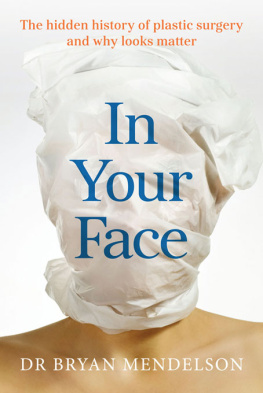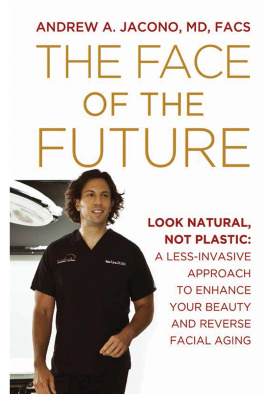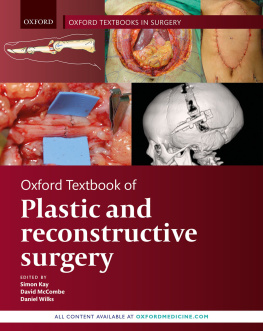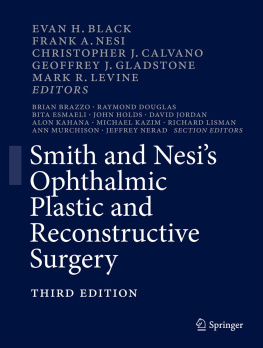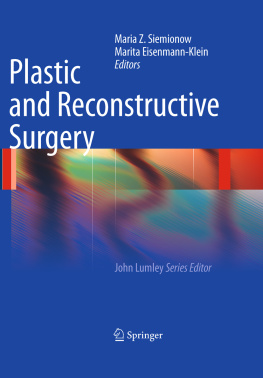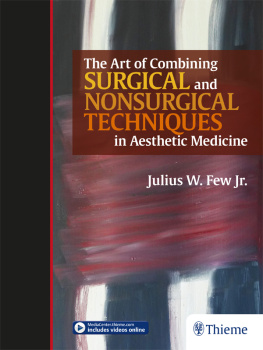Dr Bryan Mendelson is one of the worlds leading plastic surgeons. Australian born, he trained at the Mayo Clinic and the New York University Medical Centre and now practices in Melbourne, Australia. He is internationally renowned for his expertise in facial anatomy, and is a former president of the International Society of Aesthetic Plastic Surgery.
Vicki Steggall is a historian who has been writing professionally for twenty-five years, with publications in adult non-fiction and childrens literature.
In thanks to my wife, Debora, who helped me to appreciate my abilities and fulfil my potential as a plastic surgeon, and to my beautiful daughters Priscilla, Vanessa and Harriet for their love
Contents
W e live our lives behind the most observed and intriguing part of the human body: the face. When I mentioned to people that I was writing a book about the face, they responded with great interest. But when I added that it was also about my specialtyaesthetic plastic surgerymuch of their interest turned to disappointment, as if they already knew the end of the story. Theyd read about it in magazines or watched it on TV.
It seems that everyone has an opinion on the surgery I per-formsurgery for aesthetic (cosmetic) reasons to enhance facial appearancebut very few actually know anything about it. Aesthetic plastic surgery takes place behind closed doors, in a private world designed to protect the patient. This means the human stories remain undisclosed and the media, aware of the general interest in plastic surgery, fills the void with information that bears little relationship to reality. After a lifetimes work in the field, I felt it was time to tell the real story.
Our curiosity about the face and aesthetic surgery is understandable. The human face is as much a psychological space as it is physical, bearing our identity to ourselves and others. It can be an ally throughout life, bringing great ease and opportunity, or it can be an enemy, subverting progress and sapping confidence. It may never have been right to begin with, or, as with ageing, it may no longer feel right. Unlike other animals, we are judged by this mask we live behind and are obliged to accept its relentless deterioration as we age. More frequently than most of us realise, the face can be the cause of silent grief or despair.
Its not surprising, then, that the face has become a metaphor for human life. Every day we get up and face our problems, and if it all goes wrong we face the consequences. We even live in a Facebook world. If we want to hide our identity, we have to hide our face, as everyone from the hangman to the fictional superhero knows well. Without our face, we are also without our self.
That our face is so importantthat it mattersexplains why aesthetic plastic surgery also matters. Of all the surgeries, its truly about people. Plastic surgery deals with the very soul of the patient, which is why it has been called surgery of the psyche. When a person chooses to have surgery, theyre making a decisive statement about their life and how they feel about their identity. Afterwards, theyll change the signals they give out and the responses we give back. Even when the surgery is performed privately and the results are imperceptible to others, they wont be the same person. How can we not be fascinated?
It might seem a very twenty-first-century preoccupation, but the truth is this form of surgery has been with us from ancient times. Ever since weve had the means at our disposal to repair or improve facial appearance weve done so, no matter how basic those means were. Before photography and the media, even before mirrors, people risked their lives with infection and voluntarily submitted to unimaginable pain to have surgery. Their determination demonstrates that it wasnt about vanity, or the society they lived in, but something more fundamental about being human. The reasons people chose it then are the same reasons people are choosing it today.
When I decided to specialise in aesthetic surgery thirty years ago, I was still too young to really understand how strongly our face influences our lives. At first, I was surprised to see the effect surgery had on peoples lives. In the words of a famous surgeon who repaired noses nearly five hundred years ago, I watched it buoy up the spirit and help the mind of the afflicted. Which is a wonderful thing to experience. Three decades on, weve made enormous progress in understanding facial anatomy and facial ageing, which has led to increasingly refined surgical techniques. But, paradoxically, just as our ability to help people has increased so significantly, the reputation of aesthetic surgery within society has plummeted, reduced by media coverage and misinformation to a form of entertainment. This totally misses what my colleagues and I, and our patients, experience every dayand what patients and doctors throughout human civilisation have implicitly understood. In writing this book, I hope to open the doors into the private world of aesthetic plastic surgery, revealing its enduring motivations, some colourful history and characters, and the surgery itself, from the earliest operations to the most advanced procedures we perform today.
One final point. There is a lot of facial surgery performed in society by different doctors, not all of them as trained in surgery as their patients might think. This book is about surgery performed by qualified aesthetic plastic surgeons.
Theres nothing as significant as a human face. Nor as eloquent. We can never really know another person, except by our first glance at him. Because, in that glance, we know everything.
Ayn Rand
The living face is the most important and mysterious surface we deal with. It is the center of our flesh.
Daniel McNeill
O ur journey into the human face begins deep under water about 400 million years ago. If it seems a strange and remote place to start our discussion, then we need to be aware that even if weve forgotten our underwater ancestry, our body definitely hasnt. Every aspect of our human face reflects the adaptations that have taken place since our predecessors lived as underwater creaturesgliding around as solitary huntersand continued as they developed into land-based, upright creatures living in social communities. Its not possible to understand our human face without understanding each of those developmental phases: water life, early life on land, standing upright and communal living. At each stage the face adapted to help its owner survive, and each adaptation has left traces that we can see in the mirror today, as well as deeply hidden structures that a plastic surgeon deals with daily.
Fish face
Ive always liked the words of palaeontologist William K Gregory, who stated in 1929 that in the face of a shark a man may behold, as in a glass darkly, his own image, reminding us that the twenty-eight bones that form our head and face have each been inherited, in an unbroken line of succession, from an early fish-type creature. If we watch a human embryo develop during its first two months in the womb, we see a kind of time-lapse film of our evolution. At four weeks, the face of a human embryo is fish-like, complete with embryonic gill arches. Two weeks later its face looks no different from a chimpanzees at the same stage, and its only at eight weeks that it is sufficiently differentiated to be clearly human.
Think about a sharks face. Its purpose and appearance are essentially as they have been for millions of years. It could be described as a mobile food-detecting and food-trapping mask in front of the brain, a leading edge devoted entirely to survival. Its firm to the touch, allowing it to move fluently through the water. The sharks face is also expressionless, but that isnt a problem as it doesnt need to communicate its emotions to others. Without the need to communicate, the structural demands on its face are very simple: all it has to do is open and close its mouth, and it has one group of jaw-opening muscles located in front of each ear to allow it to do so. Imagine our human face with only enough facial muscles to allow us to gape as we go about our lives.

